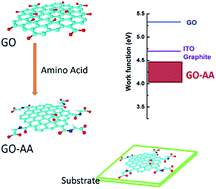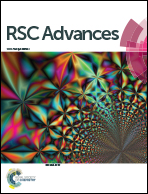Biomaterial functionalized graphene oxides with tunable work function for high sensitive organic photodetectors†
Abstract
Graphene acts as an ideal material for transparent conductive electrodes in optoelectronic devices attributed to its excellent electrical conductivity, optical transparency, and mechanical properties. Graphene oxide (GO) in the form of a colloidal suspension is considered to be more commonly useful because of its low cost and high volume production. However, controlling the work function of graphene and GO as transparent electrodes in optoelectronic devices is still a challenging task, since it is important to match the energy level of the active materials. In this study, GO sheets functionalized with amino acids were fabricated via a mild and environmentally friendly approach. The work functions of the novel amino acid functionalized graphenes and their compounds with poly(3,4-ethylenedioxythiophene) polystyrene sulfonate (PEDOT:PSS) were tuned over a wide range, which matched well with the energy of various semiconductors. Organic photodetectors with the functionalized GO exhibited the highest normalized detectivity of 5.7 × 1012 jones at −0.1 V. The results indicated that the synthesized solution-processable GO exhibits promising potential as transparent electrodes for various photoelectric devices.


 Please wait while we load your content...
Please wait while we load your content...